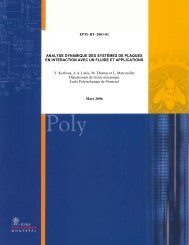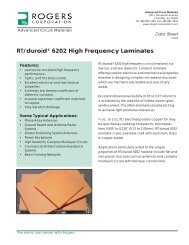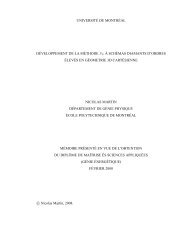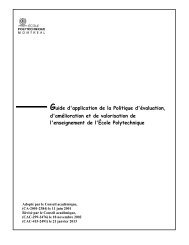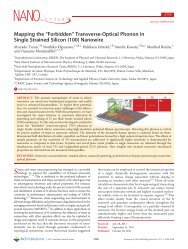XY-stage for alignment of optical elements in MOEMS
XY-stage for alignment of optical elements in MOEMS
XY-stage for alignment of optical elements in MOEMS
Create successful ePaper yourself
Turn your PDF publications into a flip-book with our unique Google optimized e-Paper software.
<strong>XY</strong>-<strong>stage</strong> <strong>for</strong> <strong>alignment</strong> <strong>of</strong> <strong>optical</strong> <strong>elements</strong> <strong>in</strong> <strong>MOEMS</strong><br />
Y.-A. Peter', H.P. Herziga and S. Bott<strong>in</strong>ellib<br />
alnstitute <strong>of</strong> Microtechnology, University <strong>of</strong> Neuchâtel,<br />
rue A.-L. Breguet 2, CH-2000 Neuchâtel, Switzerland<br />
bEcole Polytechnique Fédérale de Lausanne, Ecublens, CH-1015 Lausanne<br />
ABSTRACT<br />
The <strong>alignment</strong> <strong>of</strong> <strong>optical</strong> <strong>elements</strong> <strong>in</strong> a Micro-Opto-Electro-Mechanical System (<strong>MOEMS</strong>), is <strong>of</strong> prime importance <strong>in</strong><br />
order to realize a reliable and low loss system. Fabrication errors or temperature changes deteriorate the <strong>alignment</strong><br />
accuracy. These errors can be compensated with the aid <strong>of</strong> an active <strong>alignment</strong> system. The aim <strong>of</strong> the paper is to<br />
<strong>in</strong>vestigate an active system <strong>in</strong> order to align microlenses and fibers.<br />
A high lateral precision is required <strong>for</strong> s<strong>in</strong>gle mode fiber <strong>in</strong>jection, typically better than 1 m. The <strong>alignment</strong> along<br />
the <strong>optical</strong> axis is less critical. Our system consists <strong>of</strong> a microlens placed between one <strong>in</strong>put fiber and one output fiber.<br />
The fibers are held <strong>in</strong> V-grooves and the microlens is mounted on an <strong>XY</strong>-<strong>stage</strong>. The lens is fabricated by melt<strong>in</strong>g<br />
resist technology and subsequent etch<strong>in</strong>g <strong>in</strong> quartz. The mechanical parts are realized by wire electro-discharge mach<strong>in</strong><strong>in</strong>g<br />
(wire-EDM). Two piezo-electrical actuators move the flexible bear<strong>in</strong>gs <strong>of</strong> the <strong>stage</strong> <strong>in</strong> the X and Y direction.<br />
We will present the results obta<strong>in</strong>ed with this system and we will discuss its potential.<br />
Keywords: MOEM, Microlens, Telecommunication, Optical switch, Fiber, Alignment.<br />
1. INTRODUCTION<br />
Micro-<strong>optical</strong> and micro-electro-mechanical technologies have been highlighted dur<strong>in</strong>g the last few years. Thanks to<br />
their potential <strong>of</strong> batch process<strong>in</strong>g and cheap replication, these technologies are merg<strong>in</strong>g to create a new and broader<br />
class <strong>of</strong> micro-opto-electro-mechanical (MOEM) devices.<br />
New concepts <strong>of</strong> photonic network<strong>in</strong>g are be<strong>in</strong>g developed to <strong>in</strong>crease dramatically the data capacity <strong>of</strong> <strong>optical</strong><br />
fiber communication networks. A prototype system based on the wavelength division multiplex<strong>in</strong>g (WDM) pr<strong>in</strong>ciple<br />
is developed at the IBM Zurich Research Laboratory. It makes possible to transmit multiple data channels simultaneously<br />
at different wavelengths over a s<strong>in</strong>gle fiber. Optical switches br<strong>in</strong>g reconfigurability <strong>for</strong> transmitters and<br />
receivers as well as easy bypass<strong>in</strong>g nodes by us<strong>in</strong>g just one redundant fiber (see Fig. 1). Opto-mechanical switches<br />
will enhance the versatility <strong>of</strong> the prototype significantly.<br />
Optical switches are an attractive alternative to electrical switches <strong>in</strong> electro-<strong>optical</strong> systems, because <strong>of</strong> their low<br />
weight and immunity to electromagnetic <strong>in</strong>terference, and because they elim<strong>in</strong>ate the need <strong>for</strong> <strong>optical</strong>-to-electrical<br />
and electrical-to-<strong>optical</strong> conversion at the switch. Some non <strong>in</strong>tegrated switches are already commercialised, but<br />
all use big mechanical systems <strong>for</strong> fiber position<strong>in</strong>g and are extremely expensive. Optical switches that utilize<br />
micromechanical switch<strong>in</strong>g <strong>elements</strong> are best suited <strong>for</strong> <strong>in</strong>tegration (low price mass production) ; they can provide<br />
high contrast, large bandwidth and have multiple wavelength compatibility. The aim <strong>of</strong> our work is to develop a<br />
fiber <strong>optical</strong> switch to be used <strong>in</strong> telecommunication r<strong>in</strong>g networks. In order to have a reliable and low loss switch,<br />
the <strong>optical</strong> <strong>elements</strong> (lens, fiber) have to be aligned with a high accuracy. Two different approaches are mentioned <strong>in</strong><br />
the current <strong>MOEMS</strong> literature: passive <strong>alignment</strong> and active <strong>alignment</strong> <strong>of</strong> the components. The passive <strong>alignment</strong><br />
is realized once, generally dur<strong>in</strong>g the fabrication process.<br />
The active <strong>alignment</strong> process is more complicated as the adjustment <strong>of</strong> the <strong>optical</strong> <strong>elements</strong> is realized <strong>in</strong> real time,<br />
look<strong>in</strong>g always <strong>for</strong> the best position. Nevertheless, active <strong>alignment</strong> helps to considerably reduce the system tolerances<br />
( fabrication errors, stability) . The aim <strong>of</strong> this paper is to <strong>in</strong>vestigate an active system <strong>in</strong> order to align microlenses<br />
and fibers.<br />
For that purpose, we <strong>in</strong>vestigated an <strong>XY</strong>-<strong>stage</strong> which holds all <strong>elements</strong> <strong>of</strong> the system.<br />
Further author <strong>in</strong><strong>for</strong>mation:<br />
Email: yves-ala<strong>in</strong>.peter©imt .un<strong>in</strong>e.ch; Internet: www-imt.un<strong>in</strong>e.ch/<br />
Telephone: + 41 32 718 3283; Fax: + 41 32 718 3201<br />
202<br />
Part <strong>of</strong> the SPIE Conference on Microelectronic Structures and MEMS <strong>for</strong> Optical Process<strong>in</strong>g IV<br />
Santa Clara • September 1998 SPIE Vol. 3513 . 0277-786X198/$1O.0O
Figure 1. WDM r<strong>in</strong>g network.<br />
2. <strong>XY</strong>-STAGE<br />
The <strong>XY</strong>-<strong>stage</strong> is realized <strong>in</strong> one steel block 10x20x28 mm3 by wire electro-discharge mach<strong>in</strong><strong>in</strong>g (wire-EDM).1 Figure<br />
2 shows the <strong>stage</strong> with the flexible bear<strong>in</strong>gs. The bear<strong>in</strong>gs allow displacements <strong>of</strong> 100pm <strong>in</strong> the X and Y directions.<br />
The flexion is cont<strong>in</strong>uous and has a very good repeatability.<br />
3. EXPERIMENTAL SETUP<br />
We realized the experiments at a wavelength <strong>of</strong> A=633nm. Our system consists <strong>of</strong> a microlens placed between one<br />
<strong>in</strong>put fiber and one output fiber. The distance between fiber and lens is twice the focal length (2f) <strong>in</strong> order to have<br />
a lxi imag<strong>in</strong>g (see Fig.3).<br />
The fibers are s<strong>in</strong>gle mode fibers with a core diameter <strong>of</strong> 5jim. The fibers are held <strong>in</strong> V-grooves with a small<br />
cyl<strong>in</strong>drical magnet (see Fig. 4) . The microlens are fabricated by melt<strong>in</strong>g resist technology and transferred <strong>in</strong>to<br />
quartz by plasma etch<strong>in</strong>g.2 Their diameter is 245 pm. Two different focal length were fabricated: f1=410 pm (height<br />
h1=41.5 pm) and f2=885 im (height h2=19 pm). The quartz substrate is mounted on the <strong>XY</strong>-<strong>stage</strong> as shown <strong>in</strong><br />
Fig. 4. Two piezo-electrical actuators move the flexible bear<strong>in</strong>gs <strong>of</strong> the <strong>stage</strong> <strong>in</strong> the vertical and lateral directions by<br />
60 pm and 90pm, respectively.<br />
The fibers are mounted on a translation <strong>stage</strong> (Fig. 5) <strong>for</strong> the longitud<strong>in</strong>al adjustment along the <strong>optical</strong> axis.<br />
4. RESULTS<br />
A high lateral precision is required <strong>for</strong> s<strong>in</strong>gle mode fiber <strong>in</strong>jection, typically better than 1 pm. The <strong>alignment</strong> along<br />
the <strong>optical</strong> axis is less critical, Figure 6 and 7 show the laser beam (near the image plane) after pass<strong>in</strong>g the microlens.<br />
In Fig.6 the position <strong>of</strong> the fiber along the <strong>optical</strong> axis is adjusted. In Fig. 7 the lateral position <strong>of</strong> the microlens is<br />
203
Figure 2. X\'-<strong>stage</strong> fabricated by wire elertro—discliarge mach<strong>in</strong><strong>in</strong>g (wire- El )\1<br />
<strong>XY</strong> movable lens<br />
Input fiber<br />
Output fiber<br />
(\<br />
21 2f<br />
Figure 3. Setup <strong>of</strong> the coupl<strong>in</strong>g system. The lens ean be shifted <strong>in</strong> x and y direction.<br />
204
adjusted. 77% <strong>of</strong> the light passes through the lens. The ma<strong>in</strong> losses are due to reflections at the <strong>in</strong>terfaces and to<br />
the lens aperture.<br />
The deflection angle showed <strong>in</strong> Fig.7 is 6°.<br />
After the re-<strong>in</strong>jection <strong>in</strong>to the output fiber, we measured an efficiency <strong>of</strong> 33% (<strong>in</strong>put fiber-microlens-output fiber).<br />
5. CONCLUSIONS<br />
We <strong>in</strong>vestigated an active <strong>alignment</strong> system to be used <strong>in</strong> a micro-opto-mechanical system. This system showed<br />
promis<strong>in</strong>g <strong>for</strong> a s<strong>in</strong>gle mode fiber coupl<strong>in</strong>g. The actual system conta<strong>in</strong>s all <strong>elements</strong> <strong>for</strong> a self-align<strong>in</strong>g system, but<br />
the system is not yet <strong>in</strong>dependent <strong>of</strong> a user. Thus, the next step will be to realize an automatic system us<strong>in</strong>g a<br />
feed-back loop. Afterwards, we will extend the system to a 1x3 monomode fiber switch (Fig. 8).<br />
ACKNOWLEDGEMENTS<br />
The project was supported by the Swiss priority programs OPTIQUE II and MINAST.<br />
REFERENCES<br />
1. S. Hene<strong>in</strong>, S. Bott<strong>in</strong>elli, R. Clavel, and A. Hodac, "Wire electro-discharge mach<strong>in</strong>ed parallel spr<strong>in</strong>g <strong>stage</strong>s <strong>for</strong><br />
microrobotics," <strong>in</strong> 9th mt. Precision Eng<strong>in</strong>eer<strong>in</strong>g Sem<strong>in</strong>ar and th mt. Conf. on Ultraprecsion <strong>in</strong> Manufactur<strong>in</strong>g<br />
Eng<strong>in</strong>eer<strong>in</strong>g, pp. 448—451, 1997.<br />
2. P. Nussbaum, R. Völkel, H. P. Herzig, M. Eisner, and S. Haselbeck, "Design, fabrication and test<strong>in</strong>g <strong>of</strong> microlens<br />
arrays <strong>for</strong> sensors and microsystems." accepted <strong>for</strong> publiction <strong>in</strong> Pure & Applied Optics (nov. 97).<br />
205
206<br />
Figure 4. Detailed view <strong>of</strong> the experimental setup with ili- <strong>in</strong>put fiber and the out put fiber, the I 'Vu aettiators and<br />
the quartz iihst rate <strong>of</strong> the mierolens.
Figure 5. View <strong>of</strong> the KY-<strong>stage</strong> with the two piezo-electrical actuators and the two translation <strong>stage</strong>s <strong>for</strong> the fibers.<br />
207
Figure 6. Image spot while adjust<strong>in</strong>g the longitud<strong>in</strong>al position <strong>of</strong> the fiber.<br />
Figure 7. Iniage spot while adjust<strong>in</strong>g the lateral (left—right—left) position <strong>of</strong>t lie lens.<br />
208
209



